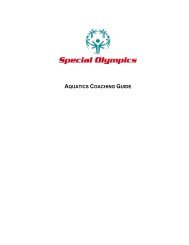BADMINTON Special Olympics Sports Skills Program
BADMINTON Special Olympics Sports Skills Program
BADMINTON Special Olympics Sports Skills Program
Create successful ePaper yourself
Turn your PDF publications into a flip-book with our unique Google optimized e-Paper software.
• Write down your goals for the season.<br />
• Become familiar with first-aid and emergency procedures<br />
for conditions that may affect people with intellectual<br />
disabilities, such as seizures.<br />
During Season<br />
• Manage your eight-week training program.<br />
• Plan your practice sessions to include skill, drill, and play<br />
experiences.<br />
• After practice sessions, consider and make adjustments<br />
that will make the next practice better and help all<br />
athletes feel and become successful.<br />
• Plan for and use both cooperative and competitive<br />
experiences throughout the season.<br />
Post-season<br />
• Evaluate your pre-season goals.<br />
• Have parents and athletes complete a program<br />
evaluation form.<br />
• Identify the successes for each athlete and share this<br />
information with the athlete and the parent(s).<br />
Suggested Topics for Beginners<br />
(in an eight-week program meeting once a week for<br />
approximately one hour)<br />
Session 1: Introduce grip, forehand ups, backhand ups,<br />
a l t e rnate ups, partner ups, underhand short serving technique,<br />
underhand cooperative rallies with a partner at mid-court and<br />
close to net (hairpin drops).<br />
Session 2: Review underhand serving and hairpin drops.<br />
Teach ready position, high deep serves (long serve), forehand<br />
overhead clear, overhead drop and underhand clear off the<br />
net. Play cooperative rallies with overhead clears and drops;<br />
play competitive short court play at the net.<br />
Session 3: Review ready position, short and long serves,<br />
and overhead clears and drops. Teach the drive shot and the<br />
overhead forehand smash. Play singles rallies.<br />
Session 4: Review all strokes. Teach the basic rules, scoring,<br />
and strategies of singles play. Play singles rallies using the<br />
singles scoring method.<br />
Session 5: Review all strokes. Teach smash defense and<br />
overhead backhand clear. Incorporate partner rally drills<br />
using a combination of strokes (see drills under each stroke<br />
section). Play.<br />
2 0<br />
Session 6: Review all strokes. Teach doubles play. Teach<br />
doubles rules and scoring, and play doubles rallies using the<br />
doubles scoring method.<br />
Session 7: Review the rules of competition and final<br />
preparation for match play. Play practice games for singles<br />
and doubles.<br />
Session 8: Set up match play.<br />
It is ex t r e m e ly difficult to create one generic eight-we e k<br />
practice plan that will fit all situations and skill levels. Please<br />
use this outline as a starting place for your practice situations<br />
and refine what you do in each practice session to best meet<br />
the needs of your athletes. If a wide range of abilities ex i s t s ,<br />
ability grouping can be ve ry useful to help your athletes<br />
practice at appropriate challenge levels. Try recruiting assistant<br />
coaches to help teach and coach athletes of differing skill<br />
l evels. Plus, a low athlete-to-coach ratio is always helpful.<br />
After the Eight-Week Season<br />
• Continue training athletes who are<br />
going on to other higher events.<br />
• Thank the facility owner/manager.<br />
• Thank the assistant coaches.<br />
• Thank the other volunteers.<br />
• Evaluate the season.<br />
• Send results to the media.<br />
• Develop next year’s season plan.

















